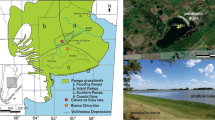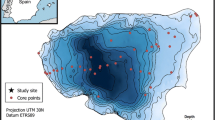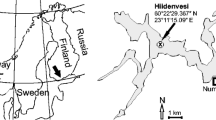Abstract
This paper presents the recent history of a large prealpine lake (Lake Bourget) using chironomids, diatoms and organic matter analysis, and deals with the ability of paleolimnological approach to define an ecological reference state for the lake in the sense of the European Framework Directive. The study at low resolution of subfossil chironomids in a 4-m-long core shows the remarkable stability over the last 2.5 kyrs of the profundal community dominated by a Micropsectra-association until the beginning of the twentieth century, when oxyphilous taxa disappeared. Focusing on this key recent period, a high resolution and multiproxy study of two short cores reveals a progressive evolution of the lake’s ecological state. Until AD 1880, Lake Bourget showed low organic matter content in the deep sediments (TOC less than 1%) and a well-oxygenated hypolimnion that allowed the development of a profundal oxyphilous chironomid fauna (Micropsectra-association). Diatom communities were characteristic of oligotrophic conditions. Around AD 1880, a slight increase in the TOC was the first sign of changes in lake conditions. This was followed by a first limited decline in oligotrophic diatom taxa and the disappearance of two oxyphilous chironomid taxa at the beginning of the twentieth century. The 1940s were a major turning point in recent lake history. Diatom assemblages and accumulation of well preserved planktonic organic matter in the sediment provide evidence of strong eutrophication. The absence of profundal chironomid communities reveals permanent hypolimnetic anoxia. From AD 1995 to 2006, the diatom assemblages suggest a reduction in nutrients, and a return to mesotrophic conditions, a result of improved wastewater management. However, no change in hypolimnion benthic conditions has been shown by either the organic matter or the subfossil chironomid profundal community. Our results emphasize the relevance of the paleolimnological approach for the assessment of reference conditions for modern lakes. Before AD 1900, the profundal Micropsectra-association and the Cyclotella dominated diatom community can be considered as the Lake Bourget reference community, which reflects the reference ecological state of the lake.







Similar content being viewed by others
References
Arnaud F (2003) Signature climatique et anthropique dans les sédiments Holocènes des Lacs du Bourget et d’Anterne (nord-ouest des Alpes) Paleohydrologie et contamination au plomb- Thèse de Doctorat, Université de Lille. http://www.epoc.ubordeaux.fr/ASF/theses/2003/ARNAUD_2003.pdf
Balvay G (1969) Aperçu sur l’état des trois grands lacs savoyards. Revue de l’institut Pasteur de Lyon 1:431–441
Battarbee RW (1986) Diatom analysis. In: Berglund BE (ed) Handbook of Holocene palaeoecology and palaeohydrology. Wiley, Chichester, pp 527–570
Battarbee RW, Carvalho L, Jones VJ, Flower RJ, Cameron NG, Bennion H, Juggins S (2001) Diatoms. In: Smol JP, Birks HJB, Last WM (eds) Tracking environmental change using lake sediments: terrestrial, algal, and siliceous indicators. Kluwer, Dordrecht, pp 155–202
Bennett KD (1996) Determination of the number of zones in a biostratigraphical sequence. New Phytol 132:155–170
Bennion H, Battarbee R (2007) The European Union Water Framework Directive: opportunities for palaeolimnology. J Paleolimnol 38:285–295
Bennion H, Fluin J, Simpson GL (2004) Assessing eutrophication and reference conditions for Scottish freshwater lochs using subfossil diatoms. J Appl Ecol 41:124–138
Bigler C, von Gunten L, Lotter AF, Hausmann S, Blass A, Ohlendorf C, Sturm M (2007) Quantifying human-induced eutrophication in Swiss mountain lakes since AD 1800 using diatoms. Holocene 17:1141–1154
Bravard JP (1987) Le Rhone du Le’man a` Lyon. La Manufacture, Lyon, p 451
Brinkhurst RO (1974) The benthos of lakes. Macmillan Press Ltd, London
Brodersen KP, Quinlan R (2006) Midges as palaeoindicators of lake productivity, eutrophication and hypolimnetic oxygen. Q Sci Rev 25:1995–2012
Brodersen KP, Pedersen O, Lindegaard C, Hamburger K (2004) Chironomids (Diptera) and oxy-regulatory capacity: an experimental approach to paleolimnological interpretation. Limnol Oceanogr 49:1549–1559
Brodin YW (1986) The postglacial history of Lake Flarken, southern Sweden, interpreted from subfossil insect remains. Int Rev Gesam Hydrobiol 71:371–432
Brooks SJ, Langdon PG, Heiri O (2007) The identification and use of palaearctic chironomidae larvae in palaeoecology. Quaternary Research Association Technical Guide, London
Brundin L (1949) Chironomiden und andere Bodentiere der Südschwedischen Urgebirgsseen. Institute of Freshwater Research, Drottningholm report 30
Chessel D, Dufour A-B, Thioulouse J (2004) The ade4 package-I- One-table methods. R News 4:5–10
Cranston PS, Oliver DR, Saether OA (1983) The larvae of Orthocladiinae (Diptera: Chironomidae) of the Holarctic region—keys and diagnoses. Entomol Scand Suppl 19:33–110
Dokulil MT, Teubner K (2005) Do phytoplankton assemblages correctly track trophic changes? An assessment using directly measured and palaeolimnological data. Freshw Biol 50:1594–1604
Espitalié J, Deroo G, Marquis F (1985a) La pyrolyse Rock Eval et ses applications. 2de partie. Rev Inst Fr Pet 40:755–784
Espitalié J, Deroo G, Marquis F (1985b) La pyrolyse Rock Eval et ses applications. 3ème partie. Rev Inst Fr Pet 41:73–89
European Union (2000) Directive 2000/60/EC of the European Parliament and of the Council of 23 October 2000 establishing a framework for Community action in the field of water policy. Off J Eur Commun L327:1–72
Gandouin E, Maasri A, Van Viet-Lanoë B, Franquet E (2006) Chironomid (Insecta: Diptera) assemblages from a gradient of lotic and lentic waterbodies in river floodplains of France: a methodological tool for paleoecological applications. J Paleolimnol 35:149–166
Gerstmeier R (1989) Phenology and bathymetric distribution of the profundal chironomid fauna in the Starnberger See (F.R. Germany). Hydrobiologia 184:29–42
Giguet-Covex C, Arnaud F, Poulenard J, Enters D, Reyss J-L, Millet L, Lazzaroto J, Vidal O (2010) Sedimentological and geochemical records of past trophic state and hypolimnetic anoxia in large, hard-water Lake Bourget, French Alps. J Paleolimnol 43:171–190
Grimm EC (2004) TGView version 2.0.2. Illinois State Museum, Research and Collections Center, Springfield
Heinis FH, Crommentuijn T (1992) Behavioural responses to changing oxygen concentrations of deposit feeding chironomid larvae (Diptera) of littoral and profundal habitats. Arch Hydrobiol 124:173–185
Heinis F, Davids C (1993) Factors governing the spatial and temporal distribution of chironomid larvae in the Maarsseveen lakes with special emphasis on the role of oxygen conditions. Neth J Aquat Ecol 27:21–34
Heiri O, Lotter AF (2001) Effect of low count sums on quantitative environmental reconstructions: an example using subfossil chironomids. J Paleolimnol 26:343–350
Hubault E (1947) Etudes thermiques, chimiques et biologiques des eaux des lacs de l’est de la France (Vosges-Jura-Alpes de Savoie). Annales des Eaux et Forêts 10:115–260
Hübener T, Adler S, Werner P, Schult M, Erlenkeuser H, Meyer H, Bahnwart M (2009) A multi-proxy paleolimnological reconstruction of trophic state reference conditions for stratified carbonate-rich lakes in northern Germany. Hydrobiologia 631:303–327
Int Panis L, Goddeeris B, Verheyen RF (1996) On the spatial distribution and respiratory environment of benthic macroinvertebrates in ponds. Hydrobiologia 319:131–136
Iovino AJ (1975) Extant chironomid larval populations and their representativeness and nature of their remains in lake sediments. PhD thesis, University of Indiana
Jackson ST, Hobbs RJ (2009) Ecological restoration in the light of ecological history. Science 325:567–569
Jacob J, Disnar JR, Boussafir M, Sifeddine A, Turcq B, Albuquerque ALS (2004) Major environmental changes recorded by lacustrine sedimentary organic matter since the last glacial maximum under the tropics (Lagoa do Caço, NE Brazil). Palaeogeogr Palaeoclimatol Palaeoecol 205:183–197
Jacob J, Disnar JR, Arnaud F, Gauthier E, Billaud Y, Chapron E, Bardoux G (2009) Impacts of new agricultural practices on soil erosion during the Bronze Age in the French Prealps. Holocene 19:241–249
Jacquet S, Briand JF, Leboulanger C, Avois-Jacquet C, Oberhaus L, Tassin B, Vinçon-Leite B, Paolini G, Druart JC, Anneville O, Humbert JF (2005) The proliferation of the toxic cyanobacterium Planktothrix rubescens following restoration of the largest natural French lake (Lac du Bourget). Harmful Algae 4:651–672
Kansanen PH (1985) Assessment of pollution history from recent sediments in Lake Vanajavesi, southern Finland. 2. Changes in the Chironomidae, Chaoboridae and Ceratopogonidae (Diptera) fauna. Ann Zool Fenn 22:57–90
Krammer K, Lange-Bertalot H (1986–1991) Bacillariophyceae. In: Ettl H, Gerloff J, Heynig H, Mollenhauer D (eds) Süßwasserflora von Mitteleuropa, Fischer, Stuttgart
Larocque-Tobler I, Heiri O, Wehrli M (2010) Late Glacial and Holocene temperature changes at Egelsee, Switzerland, reconstructed by chironomids (non-biting midges). J Paleolimnol 43:649–666
Laurent PJ (1970) Etude de la pollution du Lac du Bourget. Campagne 1969. Rapport Station Hydrobiologie Lacustre INRA
Little JL, Hall RI, Quinlan R, Smol JP (2000) Past trophic status and hypolimnetic anoxia during eutrophicaton and remediation of Gravenhurst Bay, Ontario: comparison of diatoms, chironomids, and historical records. Can J Fish Aquat Sci 57:337–341
Lods-Crozet B, Lachavanne JB (1994) Changes in the chironomid communities in Lake Geneva in relation with eutrophication, over a period of 60 years. Arch Hydrobiol 130:453–471
Lotter AF (1998) The recent eutrophication of Baldeggersee (Switzerland) as assessed by fossil diatom assemblages. Holocene 8:395–405
Lotter AF (2001) The effect of eutrophication on diatom diversity: examples from six Swiss lakes. In: Jahn R, Kociolek JP, Witkowski A, Compere P (eds) Studies on diatoms. ARG Ganther Verlag KG, Ruggell, pp 417–432
Lotter AF, Juggins S (1991) POLPROF, TRAN and ZONE: programs for plotting, editing and zoning pollen and diatom data. INQUA-Subcommission for the study of the Holocene Working Group on Data-Handling Methods. Newsletter 6:4–6
Lotter AF, Birks HJB, Hofmann W, Marchetto A (1997) Modern diatom, cladocera, chironomid, and chrysophyte cyst assemblages as quantitative indicators for the reconstruction of past environmental conditions in the Alps. I. Nutrients. J Paleolimnol 19:443–463
Meriläinen JJ, Hynynen J, Teppo A, Palomäki A, Granberg K, Reinikainen P (2000) Importance of diffuse nutrient loading and lake level changes to the eutrophication of an originally oligotrophic boreal lake: a paleolimnological diatom and chironomid analysis. J Paleolimnol 24:251–270
Meyers P, Lallier-Vergès E (1999) Lacustrine sedimentary organic matter records of late quaternary paleoclimates. J Paleolimnol 21:345–372
Meyers PA, Teranes JL (2001) Sediment organic matter. In: Last WM, Smol JP (eds) Tracking environmental change using lake sediments. vol 2: physical and geochemical methods. Kluwer, Dordrecht, pp 239–270
Millet L, Arnaud F, Heiri O, Magny M, Verneaux V, Desmet M (2009) Late Holocene summer temperature reconstruction from chironomid assemblages of Lake Anterne, northern French Alps. Holocene 19:317–328
Norberg M, Bigler C, Renberg I (2008) Monitoring compared with paleolimnology: implications for the definition of reference condition in limed lakes in Sweden. Environ Monit Assess 146:295–308
Quinlan R, Smol JP (2001) Chironomid-based inference models for estimating end-of-summer hypolimnetic oxygen from south-central Ontario shield lakes. Freshw Biol 46:1529–1541
Ramanampisoa LR, Disnar JR (1994) Primary control of paleoproduction on organic matter preservation and accumulation in the Kimmeridge rocks of Yorkshire (UK). Org Biochem 21:1153–1167
Reiss F (1968) Okologische und systematische Untersuchungen an Chironomiden des Bodensees. Ein Betrag zur lacustrischen Chironomidenfauna des nördlichen Alpenvorlands. Arch Hydrobiol 64:176–323
Renberg I (1990) A procedure for preparing large sets of diatom slides from sediment cores. J Paleolimnol 4:87–90
Saether OA (1979) Chironomid communities as water quality indicators. Holarctic Ecol 2:65–74
Scharf EA (2010) Archaeology, land use and restoration in the Yazoo Basin (Mississippi, USA). Veget Hist Archaeobot 19:159–175
Schmäh A (1993) Variation among fossil chironomid assemblages in surficial sediments of Bodensee-Untersee (SW-Germany): implications for paleolimnological interpretation. J Paleolimnol 9:99–108
Verneaux V, Aleya L (1998) Bathymetric distributions of chironomid communities in ten French lakes: implications on lake classification. Arch Hydrobiol 142:209–228
Walker IR (2001) 3- Midges: chironomidae and related diptera. In: Last WM, Smol JP (eds) Tracking environmental change using lake sediments. vol 4: zoological indicators. Kluwer, Dordrecht, pp 43–66
Wetzel RG (2001) Limnology: lake and river ecosystems. Academic Press, San Diego
Acknowledgments
The authors express their sincere thanks to Roberto Quinlan, Clément Laplaige, Damien Rius, John Olsen and Bianca Perren for their help in the writing and preparation of the manuscript. The comments of Isabelle Larocque and two anonymous reviewers are gratefully acknowledged.
Author information
Authors and Affiliations
Corresponding author
Rights and permissions
About this article
Cite this article
Millet, L., Giguet-Covex, C., Verneaux, V. et al. Reconstruction of the recent history of a large deep prealpine lake (Lake Bourget, France) using subfossil chironomids, diatoms, and organic matter analysis: towards the definition of a lake-specific reference state. J Paleolimnol 44, 963–978 (2010). https://doi.org/10.1007/s10933-010-9467-8
Received:
Accepted:
Published:
Issue Date:
DOI: https://doi.org/10.1007/s10933-010-9467-8




